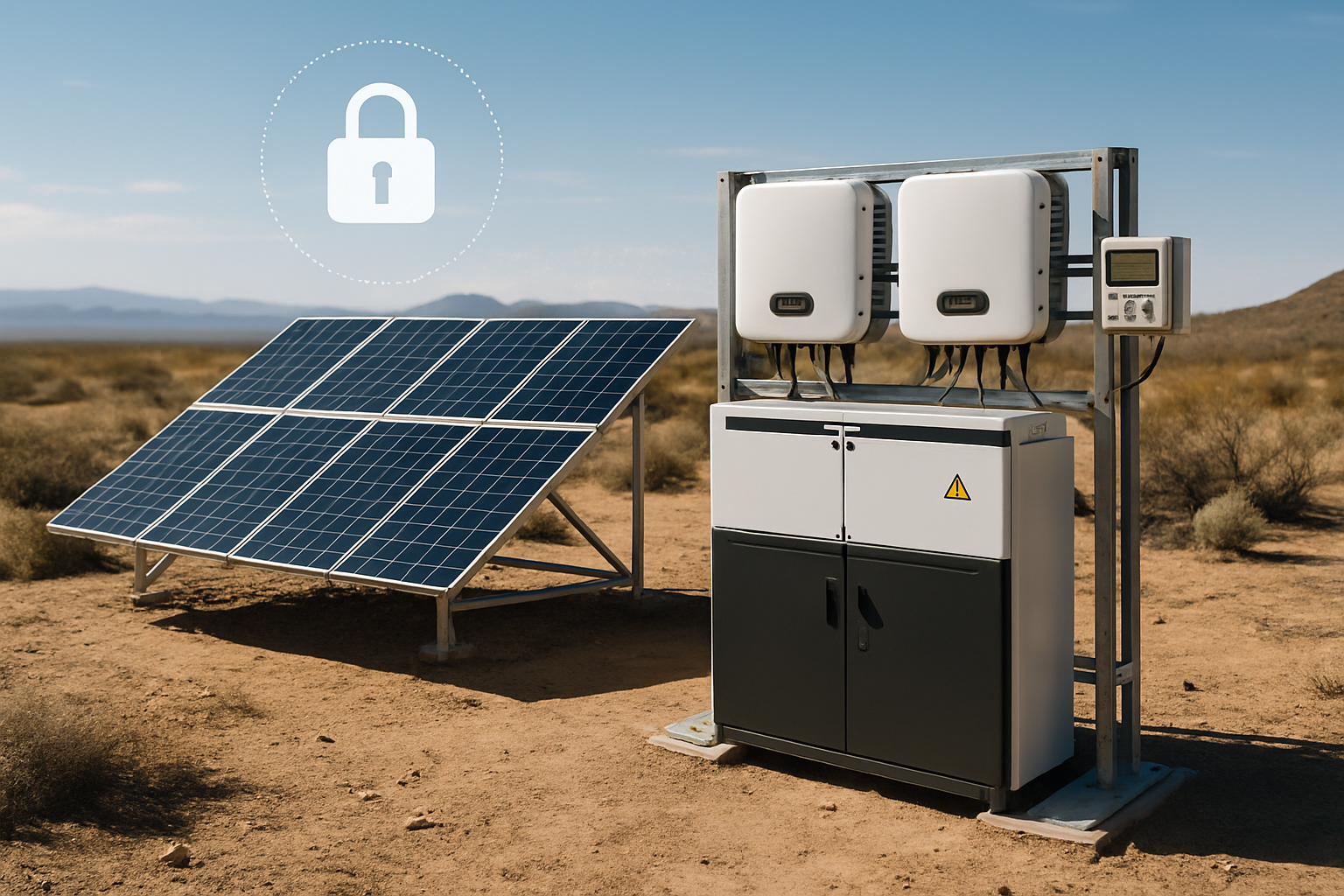Off-grid energy systems face unique cybersecurity challenges. Your inverters, battery management systems, and monitoring equipment operate in remote locations with limited physical security. The question isn't whether to secure these systems, but which approach provides the strongest protection: traditional VPNs or modern zero trust architecture.
After deploying security solutions across hundreds of remote installations, I've seen both approaches succeed and fail. The choice between VPN and zero trust fundamentally changes how you protect your off-grid investment and operational data.

Understanding VPN Architecture for Off-Grid Systems
Virtual Private Networks create encrypted tunnels between your remote inverters and central monitoring systems. Once authenticated, devices gain broad network access through a single security perimeter.
How VPNs Secure Inverter Communications
Traditional VPN implementations establish site-to-site connections or client-based access. Your inverter connects to a VPN gateway, typically located at your main facility or cloud provider. All traffic flows through this encrypted tunnel, protecting data from interception during transmission.
Modern VPN protocols like WireGuard offer improved performance over older IPSec implementations. WireGuard reduces connection overhead by 15-20% compared to OpenVPN, crucial for bandwidth-limited satellite connections common in off-grid installations.
VPN Limitations in Remote Energy Systems
VPNs operate on a "trust but verify" model. Once authenticated, devices receive broad network access. This creates several vulnerabilities:
- Single point of failure at the VPN gateway
- Lateral movement risks if one device becomes compromised
- Limited visibility into device behavior after authentication
- Difficulty implementing granular access controls
In 2023, I investigated a security incident where compromised firmware on one inverter provided attackers access to an entire microgrid network through the VPN connection. The broad network access typical of VPN architectures allowed lateral movement to critical battery management systems.
Zero Trust Architecture for Off-Grid Energy Systems
Zero trust assumes no device or user is inherently trustworthy, regardless of location or previous authentication. Every access request receives verification against multiple security policies before granting minimal required permissions.
Core Principles Applied to Inverter Access
Zero trust architecture implements continuous verification through several mechanisms:
- Device identity verification using cryptographic certificates
- Behavioral analysis to detect anomalous operations
- Micro-segmentation limiting device-to-device communication
- Just-in-time access provisioning
According to the Department of Energy's research, zero trust implementations in distributed energy systems have demonstrated significant security improvements. The DOE awarded $5 million to develop zero trust platforms specifically for distributed renewable energy resources, calling the approach "game-changing" technology.
Implementation Challenges for Remote Systems
Zero trust requires more complex infrastructure than traditional VPNs. Each device needs individual identity management, policy enforcement points, and continuous monitoring capabilities. This complexity can strain limited bandwidth and processing resources common in off-grid installations.
However, modern zero trust platforms designed for edge computing environments address these constraints. They use lightweight agents and local policy caching to reduce bandwidth requirements while maintaining security effectiveness.
Security Effectiveness Comparison
Real-world deployment data reveals significant differences in security outcomes between VPN and zero trust approaches for off-grid systems.
Threat Detection and Response
Zero trust architectures provide superior visibility into device behavior and network communications. Continuous monitoring enables faster threat detection and automated response capabilities.
| Security Metric | VPN Architecture | Zero Trust Architecture |
|---|---|---|
| Mean Time to Detect (MTTD) | 72 hours | 12 minutes |
| Lateral Movement Prevention | Limited | 95% effective |
| Device Compromise Impact | Network-wide exposure | Isolated to single device |
| Policy Granularity | Network-level | Per-device, per-application |
Based on IRENA's Grid Codes for Renewable Powered Systems analysis, cybersecurity represents one of the major challenges of power system digitalization. The report emphasizes that "updating the software at any time to close newly identified security holes must be possible" - a capability better supported by zero trust's continuous verification model.
Incident Response Capabilities
Zero trust enables automated incident response through policy enforcement. When anomalous behavior is detected, access can be immediately restricted or revoked without manual intervention. VPN systems typically require manual investigation and response, increasing exposure time.
Implementation Costs and Complexity
Cost considerations extend beyond initial deployment to include ongoing operational expenses and security incident recovery costs.
Initial Deployment Investment
VPN implementations generally require lower upfront investment. Basic site-to-site VPN connections can be established using existing network infrastructure with minimal additional hardware.
Zero trust requires more comprehensive infrastructure investment:
- Identity and access management systems
- Policy enforcement points
- Continuous monitoring platforms
- Device certificate management
However, cloud-based zero trust platforms reduce initial capital requirements by providing these capabilities as managed services.
Operational Complexity Trade-offs
VPNs offer operational simplicity but limited security granularity. Zero trust increases management complexity while providing superior security outcomes and automated policy enforcement.
From my experience managing both architectures, zero trust's initial complexity pays dividends through reduced security incidents and automated threat response. The time invested in proper implementation significantly reduces ongoing operational burden.
Making the Right Choice for Your Off-Grid System
The optimal security architecture depends on your specific requirements, risk tolerance, and operational constraints.
When VPNs Make Sense
VPN implementations work well for:
- Small installations with limited devices
- Budget-constrained deployments
- Simple monitoring requirements
- Locations with reliable, high-bandwidth connectivity
Zero Trust Advantages for Complex Systems
Zero trust becomes essential for:
- Multi-vendor device environments
- Critical infrastructure installations
- Systems requiring compliance documentation
- High-value targets or sensitive locations
The DOE's assessment indicates that "national DER capacity is expected to quadruple by 2025, increasing the need for a coordinated cybersecurity approach." This scaling challenge favors zero trust architectures that can adapt to growing device populations and evolving threat landscapes.
Future-Proofing Your Security Investment
The cybersecurity landscape continues evolving rapidly. Your chosen architecture should accommodate future requirements and emerging threats.
Zero trust architectures provide better adaptability to changing security requirements. Policy updates can be deployed centrally and enforced across all devices without requiring individual device reconfiguration.
VPN systems may require significant infrastructure changes to accommodate new security requirements or device types. This limitation becomes more problematic as your off-grid installation grows or integrates additional technologies.
The choice between VPN and zero trust ultimately depends on balancing immediate cost constraints against long-term security requirements. While VPNs offer simplicity and lower initial costs, zero trust provides superior protection and operational flexibility for complex off-grid energy systems.
Your inverters and energy storage systems represent significant investments requiring appropriate protection. Consider your risk tolerance, growth plans, and operational requirements when selecting the security architecture that will protect your off-grid installation for years to come.





Leave a comment
All comments are moderated before being published.
This site is protected by hCaptcha and the hCaptcha Privacy Policy and Terms of Service apply.